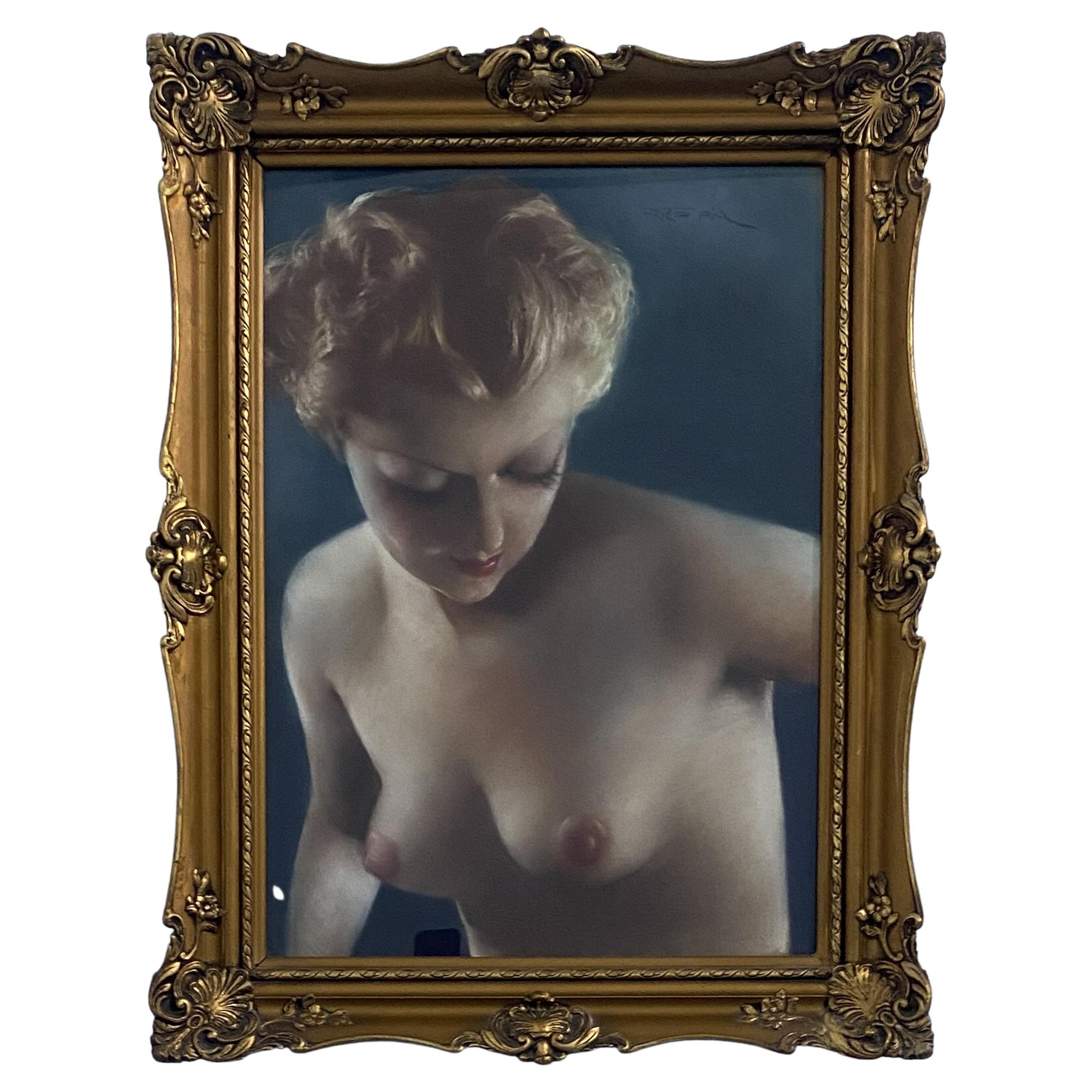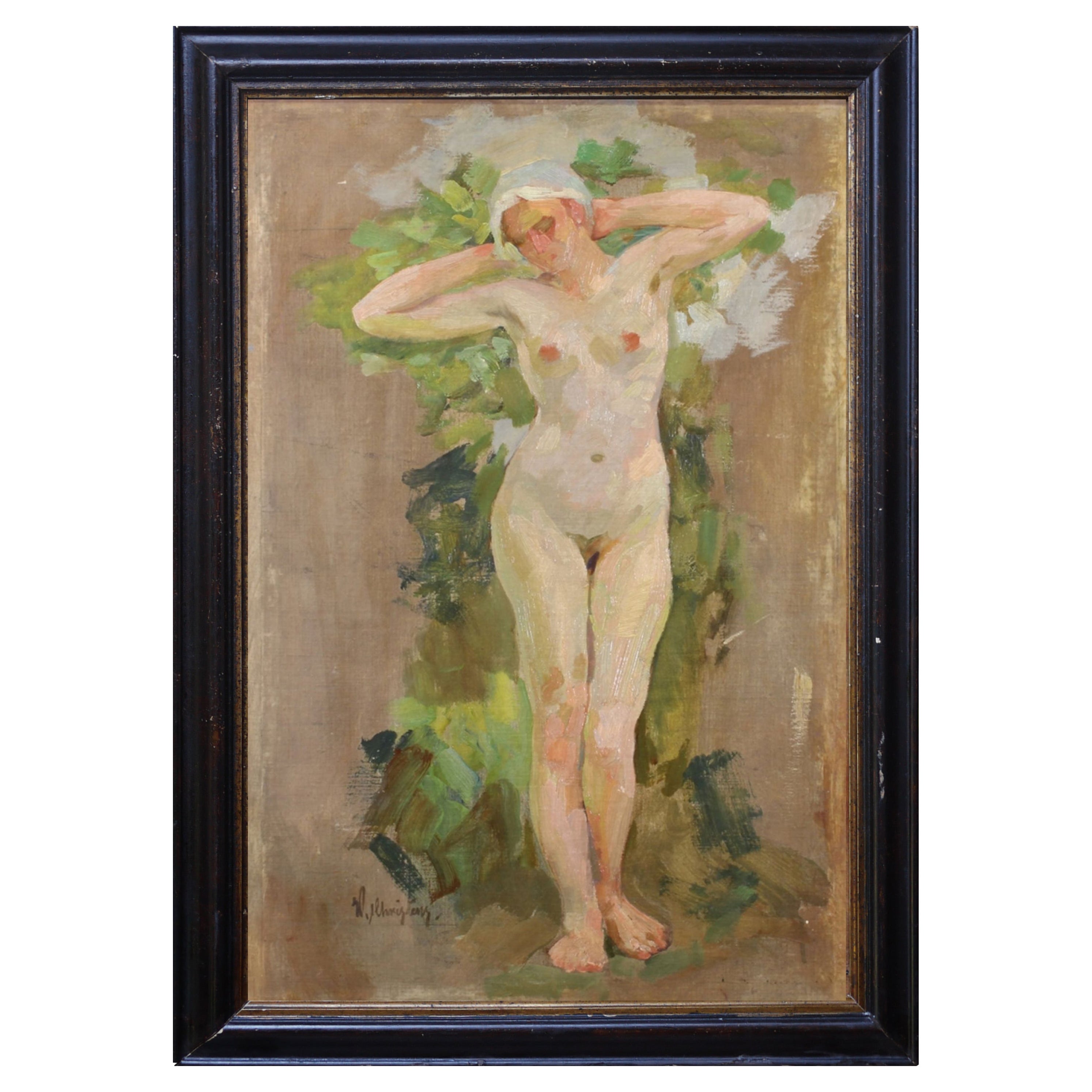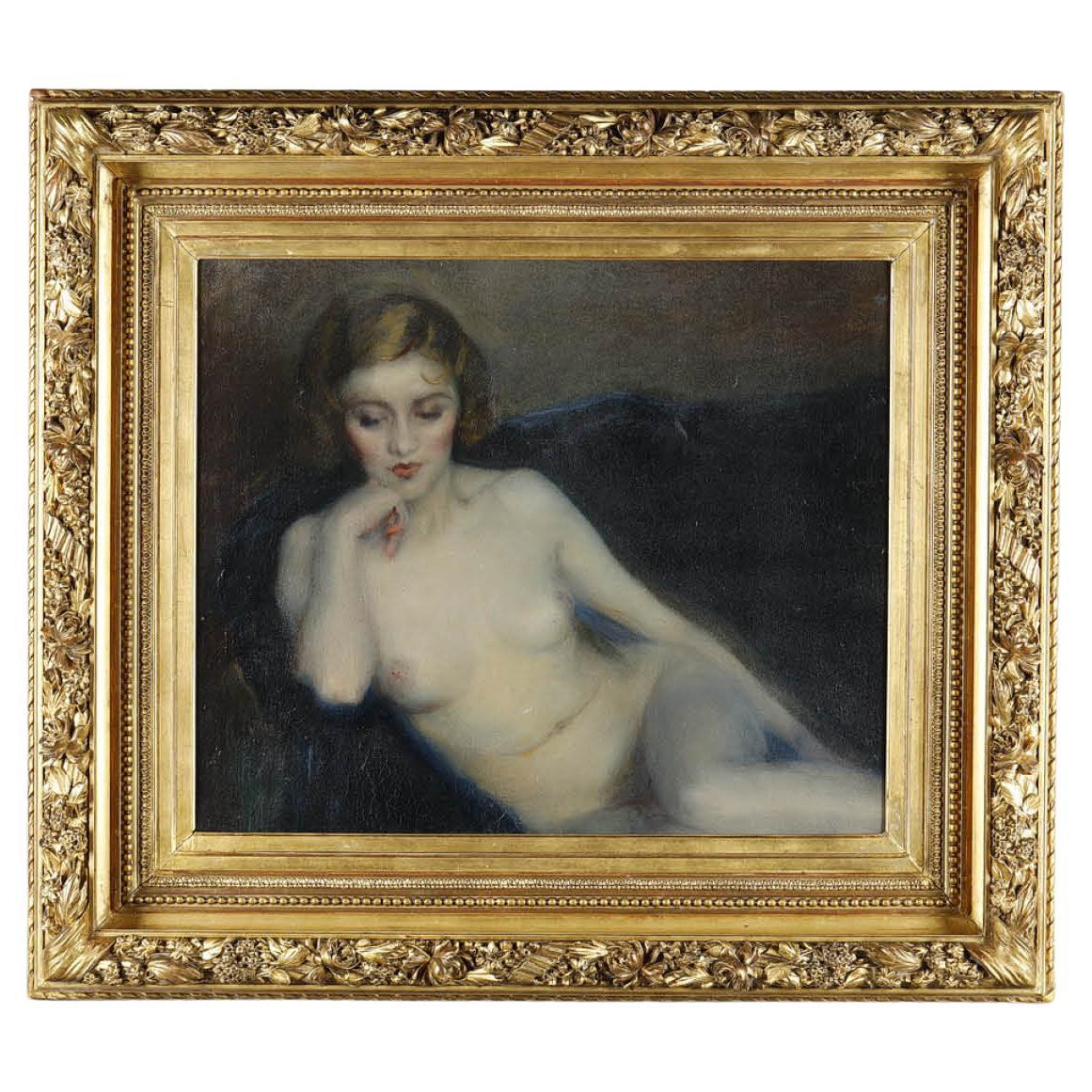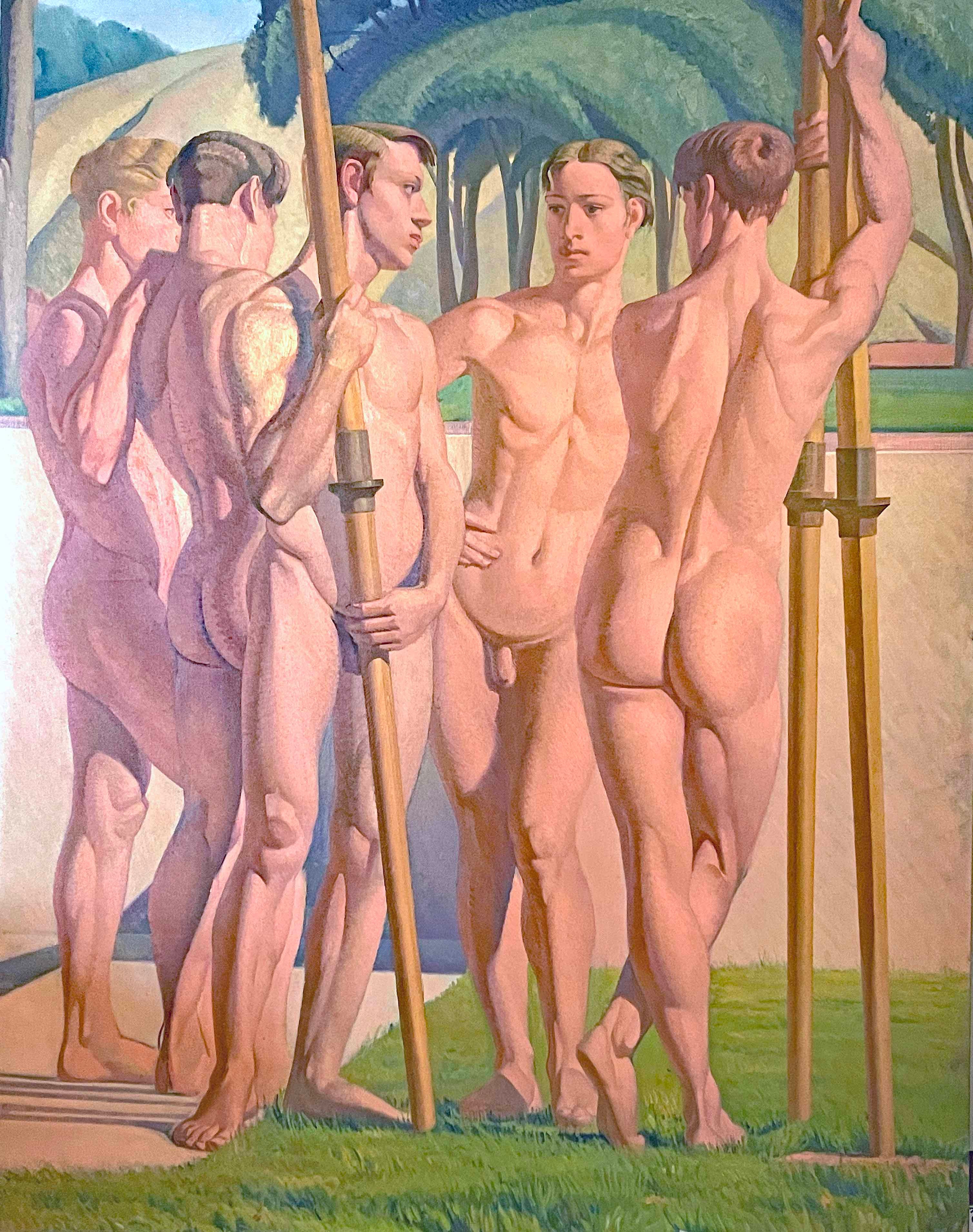Items Similar to 1930s Francesco Galante Painting Nude of Woman
Want more images or videos?
Request additional images or videos from the seller
1 of 7
1930s Francesco Galante Painting Nude of Woman
About the Item
Great Italian artist Francesco Galante wonderful oil on round canvas painting
Modern art Nude of a Seated Woman signed lower left by Francesco Galante.
Brass label with name and date of birth and death of the artist.
This painting, never before on the market, comes from a private collection and is beautified by an impressive antique frame in gilded wood, in almost perfect condition.
Every item of our Gallery, upon request, is accompanied by a certificate of authenticity issued by Sabrina Egidi official Expert in Italian furniture for the Chamber of Commerce of Rome and for the Rome Civil Courts.
FRANCESCO GALANTE
Born in Margherita di Savoia
He soon moved to Naples where he attended the institute of fine arts.
He was a pupil of Michele Cammarano and Vincenzo Volpe and student, collaborated with various Neapolitan newspapers as an illustrator.
Even in his painting activity, which he started in parallel with his graphic work, Francesco Galante.
However, this tendency soon came to coexist with a substantial predilection for an intimism of atmospheres, themes and decorative cues.
Francesco Galante's culture in these years did not differ from that common to many artists of his generation, variously oriented toward modernist currents in the search for greater autonomy from the traditional environment.
Already present since 1904 at the exhibitions of the Promotrice Salvator Rosa in Naples, in 1909 he joined the "Secessione dei ventitré "With these of Francesco Galante he organized I' Esposizione giovanile in Naples.
In 1905 he took part in the Salon d'automne in Paris and in the LXXIX Roman Exhibition of the Society of Amateurs and Connoisseurs of Fine Arts, where he exhibited Marechiaro and Studio (Rome, National Gallery of Modern Art); in 1910 he made his debut at the Venice Biennale, an exhibition that would see him present until the 13th edition in 1922.
In 1911 G. was engaged to decorate the central hall of the pavilion of Campania, Basilicata and Calabria at the Fiftieth Anniversary Ethnographic Exhibition held that year in Rome. In the capital, the artist returned two years later to participate in the I Roman Secession Exhibition and where he was engaged to decorate the pavilion of Campania, Basilicata and Calabria at the Ethnographic Exhibition in Rome.
Francesco Galante began at this time to distance himself from the Secessionist movement, aligning himself with more traditionalist positions.
After the wartime interlude spent at the front, he resumed his exhibition activity in 1919 (International Exhibition in Turin and I Mostra "La Floridiana" in Naples).
In 1921 he took part in Naples in the Mostra d'arte dei grigio-verdi and in the I Biennale nazionale d'arte, and a few years later followed the Novecen
Francesco Galante continued, meanwhile, a lively exhibition activity, participating, among other things, in the Novecento exhibitions set up by Margherita Sarfatti in various cities in Europe in the late 1920s (Il premio Bergamo, 1993, p. 206); in those of the Naples Polytechnic, where in 1931 and in the first edition of the Bergamo Prize (1939).
In the 1930s Francesco Galante received some prestigious official commissions, such as the decoration of the ceiling of the Mercadante theater in Naples (1936), with an allegory of the city, and the facade of the pavilion dedicated to Italian labor in Africa at the Mostra d'Oltremare in Naples (1940), to which he would later add the fresco Le nozze di Anfitrite con Poseidone (1953) for the ceiling of the court theater in the royal palace in Naples.
The dimensions are frame included
This artwork is shipped from Rome. Under existing legislation, any artwork in Italy created over 70 years ago by an artist who has died can requires a license for export regardless of the work’s market price. The shipping may require additional handling days to require the license according to the destination of the artwork.
- Creator:Francesco Galante (Author)
- Dimensions:Height: 19.69 in (50 cm)Width: 19.69 in (50 cm)Depth: 1.97 in (5 cm)
- Style:Belle Époque (Of the Period)
- Materials and Techniques:
- Place of Origin:
- Period:
- Date of Manufacture:1935 ca.
- Condition:Wear consistent with age and use. Minor fading.
- Seller Location:Roma, IT
- Reference Number:1stDibs: LU4827237413902
About the Seller
5.0
Vetted Seller
These experienced sellers undergo a comprehensive evaluation by our team of in-house experts.
Established in 2005
1stDibs seller since 2019
71 sales on 1stDibs
Typical response time: 1 hour
- ShippingRetrieving quote...Ships From: Rome, Italy
- Return PolicyA return for this item may be initiated within 14 days of delivery.
More From This SellerView All
- Francesco Vinea Portrait of a Young Gentlewoman PaintingBy Francesco Vinea 2Located in Roma, ITFrancesco Vinea portrait of a woman Portrait of Empire taste Work by painter Francesco Vinea ( Forli 1845- Florence 1902). Oil on canvas, depicting a young woman in Empire style in r...Category
Antique 19th Century Italian Empire Paintings
MaterialsCanvas, Wood
- Frank Dobson Modern Drawing Female NudeBy Frank DobsonLocated in Roma, ITRed chalk drawing of a reclining Female nude Signed and dated by Frank Dobson This drawing, never before on the market, comes from an important European private collection and is beautified by an antique frame in gilded wood, in almost perfect condition. The painting is also protected by glass Dimensions whit frame cm 71 x 58.5 Every item of our Gallery, upon request, is accompanied by a certificate of authenticity issued by Sabrina Egidi official Expert in Italian furniture for the Chamber of Commerce of Rome and for the Rome Civil Courts. Frank Owen Dobson (London 1886 – 1963) was a British artist and sculptor. Dobson began as a painter, and his early work was influenced by cubism, vorticism, and futurism. After World War I, however, he turned increasingly toward sculpture in a more or less realist style. Throughout the 1920s and the early 1930s he built a reputation as an outstanding sculptor and was among the first in Britain to prefer direct carving of the material rather than modelling a maquette first. The simplified forms and flowing lines of much of his sculptures, particularly his female nudes, showed the influence of African art. From 1946 to 1953 Dobson was Professor of Sculpture at the Royal College of Art. He was elected to the Royal Academy in 1953. While Dobson was one of the most esteemed artists of his time, is now seen as one of the most important British sculptors of the 20th century. Dobson grew up in Clerkenwell where attended school in Forest Gate. After eighteen months in Reynolds-Stephen's studio, Dobson moved to Devon and then to Cornwall where he lived, for two years, by selling landscape paintings. In 1906 he obtained a scholarship to study at the art institute in Hospitalfield House in Arbroath and studied there for four years. From 1910 to 1912 Dobson attended the City and Guilds of London Art School in Kennington, after which he returned to Cornwall. In Newlyn, he met Augustus John who used his influence and contacts and in, or around, 1915 Dobson created his first sculpture, a small piece in wood. In 1915, during the First World War, Dobson enlisted in The Artists Rifles and served in France from October 1916. In April 1918 he married Cordelia Clara Tregurtha. Dobson was formally invalided out of the Army in November 1918 and by then had already submitted several drawings to the British War Memorials Committee. Dobson set up a studio in the Tregurtha family home in Newlyn but towards the end of the war he took a studio in Manresa Road in Chelsea and would live there until the start of the Second World War. Throughout the 1920s Dobson focused increasingly on sculpture, exhibited work in several influential exhibitions and played a leading role in a number of artistic groups. He was the only sculptor to take part in the 1920 Group X exhibition. Dobson was a founding member of the London Artists Association and spent three years as President of the London Group between 1923 and 1927. He made bronze portraits of several public figures. At the Group X exhibition he exhibited two sculptures and studies of Ben Nicholson and his bronze head of H. H. Asquith was shown at the Leicester Galleries in late 1921. Other subjects included Osbert Sitwell, Lydia Lopokova and Tallulah Bankhead. Dobson exhibited at the Venice Biennale in both 1924 and in 1926, was featured in the 1925 Tri-National Exhibition which visited London, Paris and New York and was also included in the 1926 European artists exhibition that toured America and Canada. In March 1927 he had his first major one-man exhibition when the Leicester Galleries exhibited twenty-three of his sculptures and several bronzes. In 1930 the Tate purchased a larger-than-life sculpture from Dobson and erected it outside the gallery on Millbank. During the early 1930s Dobson continued to receive portrait commissions, most notably for Sir Edward Marsh and the actress Margaret Rawlings. Dobson worked in other media including textiles and silver, as well. His silver gilt cup, Calix Majestatis, to mark the coronation of George VI and Queen Elizabeth is now in the Royal Collection. During 1933 Dobson fractured his left arm which greatly limited his ability for heavy carving and his last monumental stone carving was to be Pax, which was first shown at the London Group in 1935. At the start of World War Two, Dobson and his second wife [Caroline] Mary Bussell, whom he had married in 1931, moved to Bristol, where a large retrospective of his work was held in March 1940. Dobson lived in the city throughout the Bristol Blitz and like several other artists painted the ruins of churches destroyed in the bombing. Dobson contacted the War Artists' Advisory Committee and offered his services as both a painter and sculptor. WAAC were reluctant to offer sculpture commissions but eventually did offer Dobson a short-term contract for two portrait busts of Naval personal. Later WAAC commissioned some paintings, including one of workers arriving for work at a factory that had been relocated to a tunnel. Dobson was appointed head of sculpture at the Royal College of Art in 1946, a post he held until his retirement in 1953. For the Festival of Britain site on the South Bank of the Thames in 1951, Dobson created London Pride. The sculpture was originally exhibited as a plaster cast but was later, after Dobson died, cast as a bronze and placed in front of the Royal National Theatre in 1987. Among his last commissions were a bronze head of Sir Thomas Lipton and the zodiac clock...Category
Vintage 1930s British Modern Paintings
MaterialsGlass, Wood, Paper
- Modern Signed Oriental Watercolor Woman with ChildLocated in Roma, ITWonderful Modern signed oriental watercolor Woman and Child with a fish Every item of our Gallery, upon request, is accompanied by a certifica...Category
Early 20th Century Mid-Century Modern Paintings
MaterialsPaper
- Lake Landscape Painting on Canvas signed by Rudolf Swoboda the YoungerBy Rudolf SwobodaLocated in Roma, ITLake landscape with noble figures by lush plant life, early 20th century, signed and dated Swoboda 1912. Rudolf Swoboda the Younger was a great Viennese artist who lived between the 19th and 20th centuries. Coming from a family of artists, he learned painting techniques in the atelier of his uncle Leopold Carl Müller...Category
Vintage 1910s Austrian Belle Époque Paintings
MaterialsCanvas
- Pair of 19th Century Rembrandt Follower PaintingBy Rembrandt van RijnLocated in Roma, ITPair of important oil paintings by a follower of Rembrant The two works represent two celebrated paintings : "The Anatomy Lesson of Dr. Nicolaes Tulp" and "The Sampling Officials." ...Category
Antique 1890s Italian Baroque Paintings
MaterialsWood
- Young Woman Portrait by Enrico Crespi Signed Located Dated Italian WatercolorLocated in Roma, ITBeautiful and evocative watercolor technique painting by the great Milanese school artist Enrico Crespi It depicts a young woman lying dreamily on her bed. Most likely this is a youn...Category
Vintage 1920s Italian Art Deco Paintings
MaterialsWood, Paper
You May Also Like
- Art Deco pastel painting "Nude of a Woman" signed Fried Pal, 1930sBy Pal FriedLocated in Traversetolo, ITStupendous pastel painting designed by Fried Pal in the 1930s,the theme of the nude in the Art Deco period was of important relevance,the author in this painting demonstrates great s...Category
Vintage 1930s American Art Deco Paintings
MaterialsGlass, Wood, Paper
- Nude Painting, Wilhelm Christens, 1930sLocated in Albignasego, ITWilhelm Christens - female nude 64cm x 42cm (frame excluded) - oil on canvas applied to rigid cardboard 1920s Christens, Wilhelm (1878 Düsseldorf - 1964) He attended the Karl...Category
Vintage 1930s German Paintings
MaterialsPaint
- 1930s Nude Oil Painting Signed MaubriLocated in Cathedral City, CAFrench nude painting (oil on canvas) with original frame signed Maubri.Category
Vintage 1930s French Art Deco Paintings
MaterialsWood, Canvas
- "Nude Male Bathers, " 1930s Watercolor Painting of Nude Figures, Blue & TanLocated in Philadelphia, PAStrikingly and vividly painted in watery tones of blue, green, tan and rose, this watercolor painting by Jean Paul Slusser depicts three nude male bathers...Category
Vintage 1930s North American Art Deco Paintings
MaterialsPaint
- Art Deco painting "Female Nude", French school of the 1930sLocated in Paris, FRArt Deco painting in oil on canvas illustrating a young nude woman, pensive, half lying down, in front and the face resting on her right hand. Her skin is clear and she wears a short hairstyle in the fashion of the 30s. A certain light emanates from this work which takes up a classic theme of Western art: the female nude. This Art Deco painting is not signed but can be linked to the work of the French...Category
Early 20th Century French Art Deco Paintings
MaterialsCanvas, Giltwood
- "Five Olympic Rowers", Monumental 1930s Painting of Nude Male OarsmenLocated in Philadelphia, PAOne of the most stunning and monumental depictions of male nude figures -- and male athletes -- ever accomplished in the Modern era, this large painting shows five nude rowers, relaxed and conversational, as they hold their oars and await the next round of competition. The figures are shown with flushed, ruddy complexions, contrasting with the fresh green of the grass and trees surrounding them. The artist, James Stroudley, presents his rowers as consummate modern British men...Category
Vintage 1930s British Art Deco Paintings
MaterialsPaint





